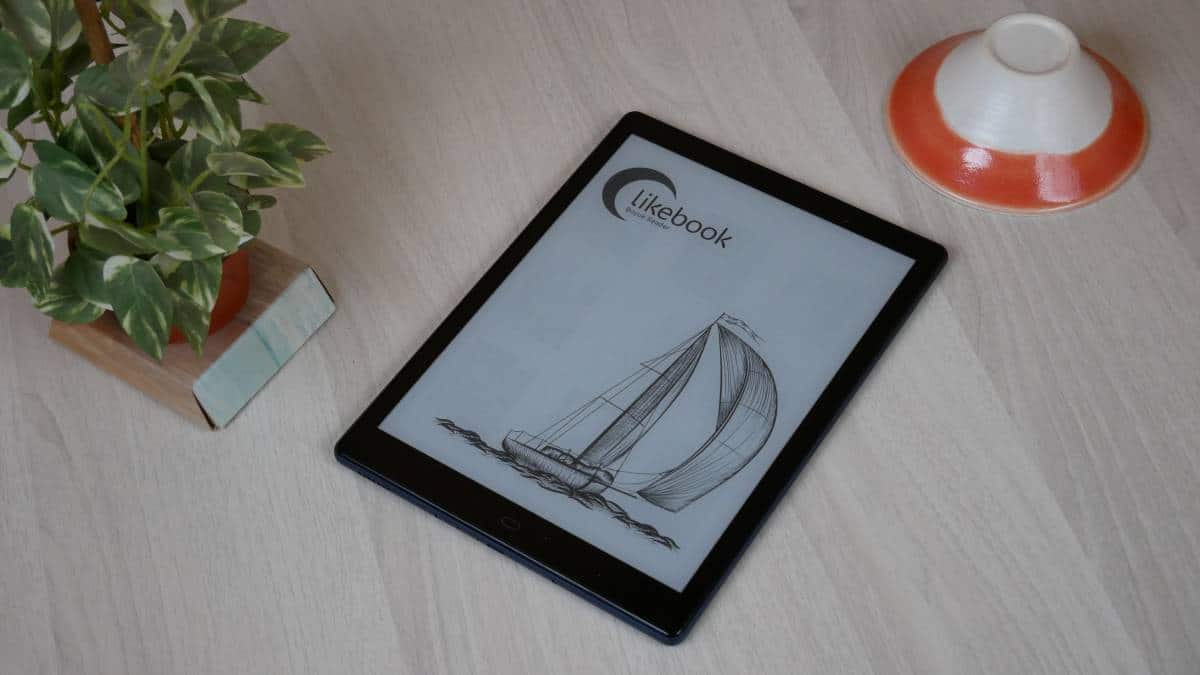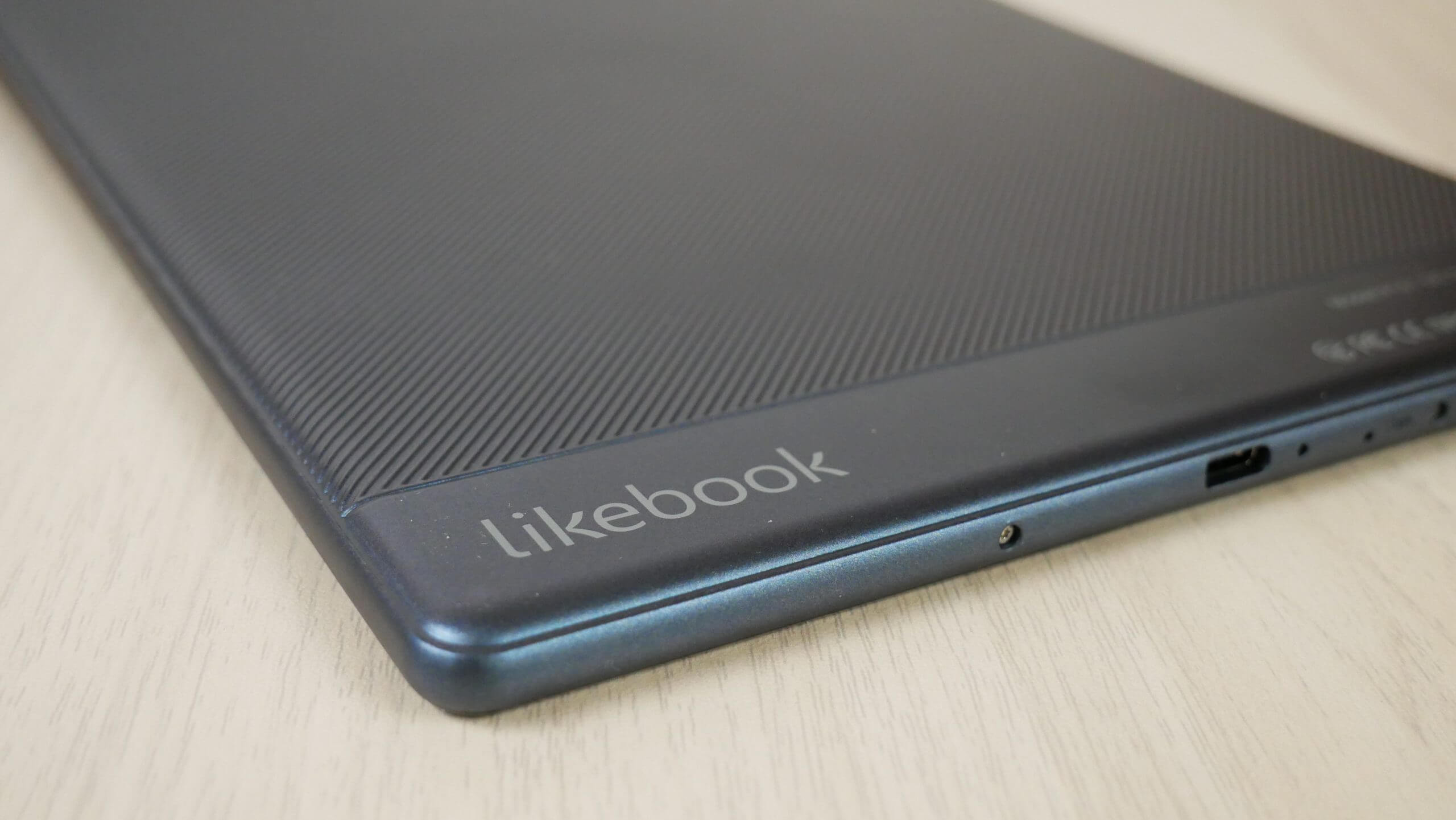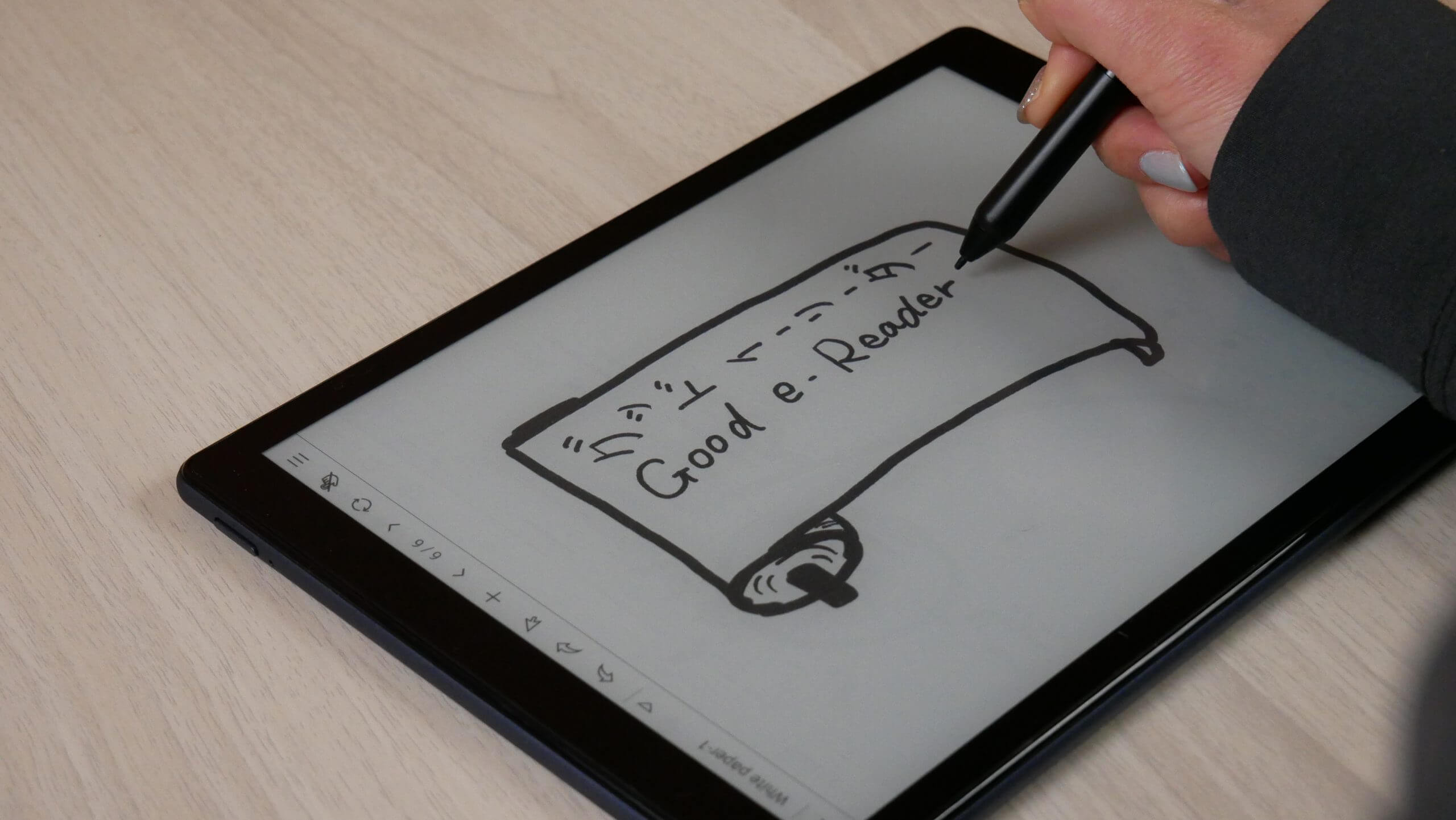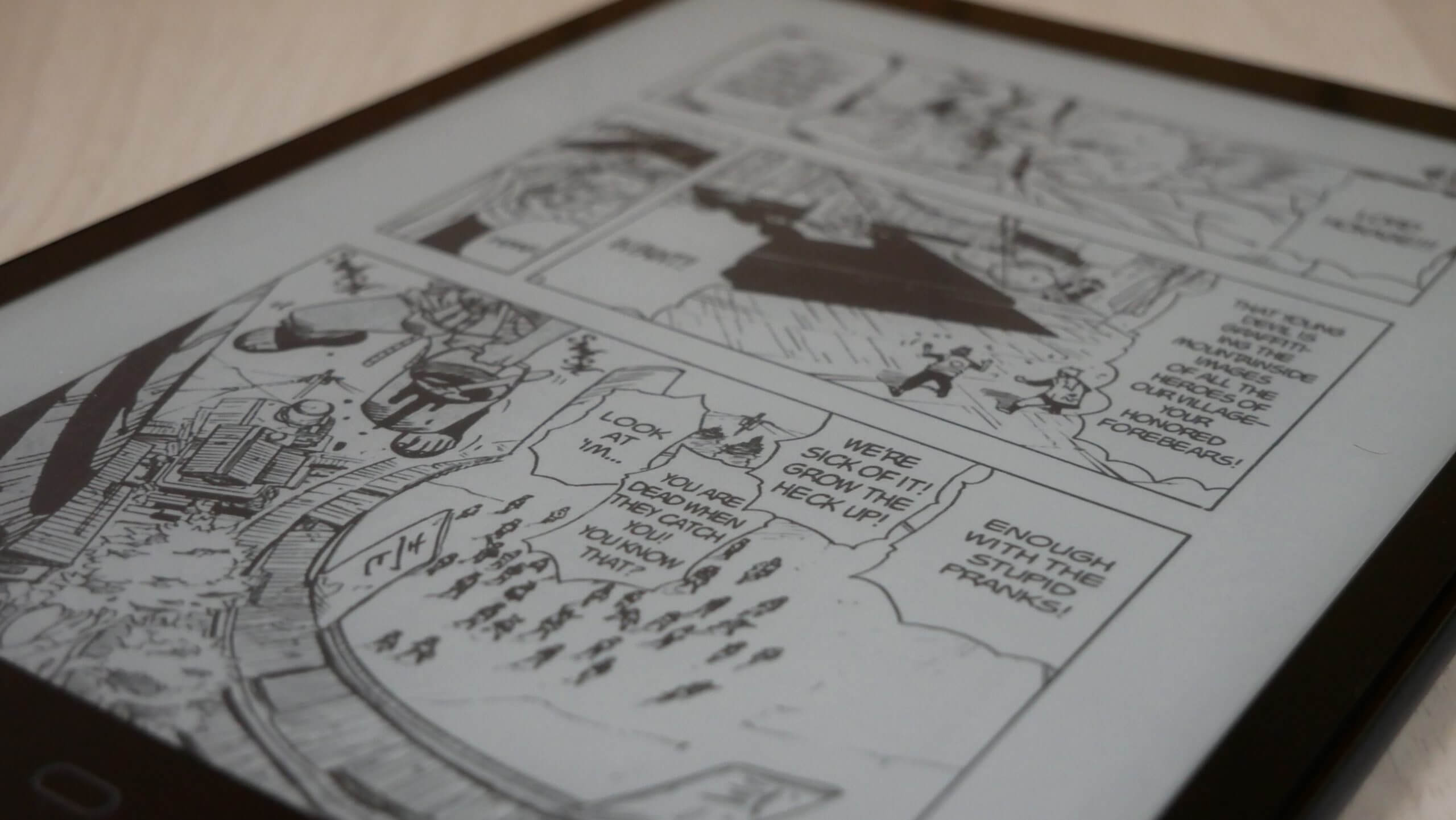The Boyue Likebook P10 is billed as a 10 inch dedicated e-reader, but it also comes with an optional stylus. This is used to take notes, edit PDF files and annointate ebooks. The latency when drawing is very low, because the P10 does not have a WACOM screen, instead it is an active stylus that is powered by a battery and has pressure sensitivity. This Android 8.1 device has Google Play out of the box and provides tremendous value, it costs $349 and comes with a free case, stylus and replacement nibs from the Good e-Reader Store.
Hardware
The Likebook P10 features a 10 inch capacitive touchscreen display with E INK Carta HD e-paper technology. It has a resolution of 1200×1600 and 200 PPI. It has 28 LED lights, they offer a combination of white and amber, this is used for the front-lit display and color temperature system. The screen is completely flush with the bezel and has a layer of glass. It does not have a WACOM display, which helps cut down on the price. On the back of the P10, there is a blue design, which is perforated, which helps with the grip.
The P10 is not employing a WACOM screen, so most pens will not interact with it. Instead, Boyue is using an their own proprietary active capacitive pen, this is similar to what Sony did with their own stylus for the Digital Paper. The Boyue stylus is not compatible with any other e-readers that I tested. It is powered by a single battery, that comes with the stylus, when it is not in use, it draws no power, so it will last a very long time. The decision to go with a battery is odd, considering most other active stylus pens, such as the aforementioned Digital Paper and Apple Pencil need to be recharged on a regular basis.
The inclusion of a stylus makes the P10 a very underrated digital note taking device. The drawing software is not as advanced as dedicated e-notes, such as the Likebook Mimas, Muses, Alita or Ares. This is because these are running completely different software and their note taking features are very advanced. The P10, would be considered a hybrid, you can select various pens, pencils or pen colors. It has a handwriting to text conversion engine, so when you write text, it will automatically convert it. It is not marketed as a e-note, but you can craft to-do-lists, some light note taking, editing and signing PDF documents and freehand draw.
Underneath the hood is a quad core 1.5 GHZ CPU processor, 2 GB of RAM and 64 GB of internal storage, there is no SD card to enhance the storage further. It has WIFI 2.4GHZ, 5.0GHZ, which is used for browsing the internet or downloading apps. Bluetooth 5.0 will ensure that you can plugin a pair of wireless headphones or earbuds and listen to audiobooks, music, podcasts or TTS e-reading apps. There is a single mono speaker the bottom, next to the USB-C port. It is powered by a 3,900 mAh battery, which should last a couple of weeks, before a recharge. It has USB-C to recharge the device by plugging it into your computer or a wall outlet. The dimensions are 178x239x8.5 and weighs 458g.
The P10 a pure hardware level, provides a ton of value. There are no other 10 inch e-readers on the market, except for the Pocketbook InkPad X, which is more expensive, running Linux and doesn’t support apps. I believe the P10 is the best bang for your book right now, Boyue is back.
Software
The Likebook P10 is running Google Android 8.1 out of the box. This gives you full access to Google Play, without the need to install anything extra. You can basically get going right away by attaching your Google Account in the settings menu and login to Google. You can access all of the paid apps that you have made on your smartphone or tablet, as well as a wide selection of content. Google Play on an e-reader is critical, and if this is important to you, buy the P10.
Boyue has revised their home screen and provides a vastly different software experience than the Likebook Mars, Alita, Muses, Mimas, Ares or Alita. Boyue did this because their core focus right now is expanded into consumer driven e-readers, that are often more affordable than digital note taking devices, because WACOM screens and all of the internals are often expensive.
The UI comprises of bright and bubbly boxes, which are shortcuts to various aspects of your device. By default there are 8 boxes. There is a setting to to expand the boxes, to fit even more on the screen or less. There is an option in the settings menu to adjust the homescreen. So you can remove the ones you don’t normally use and keep the ones you do. For example, I don’t often visit the gallery or downloads, so I removed them from the home screen and instead have shortcuts to launch the Kindle app and Comixology. The home screen is tremendously flexible, so you can keep the things you access regularity and remove the ones you don’t.
The stock options on the home screen out of the box is library, internet browser (webkit), gallery, music player, settings, file manager , downloads, dictionary and apps. On the top left, there is the home screen button, back button, refresh and front-lit display option to control the luminosity. These are software based features, because Boyue eliminated hardware buttons awhile ago. On the top right of the screen is an option to view all of the open apps and background processes, which you can close. There is also WIFI connectivity symbol, battery life remaining and a clock.
One of the things I like about the UI/software is the new file manager. If you sideload things onto the root directly, it will break everything down. It will show you how many EPUB ebooks you have, and group them, showing a numerical value. Ditto with txt files, PDFS, Mobis, DOCX, ZIP, APKS and Pictures. I have never seen a file system like this on an e-reader before.
There are a few global options that will allow you to craft the Boyue P10 to your liking. If you drag your finger from the top/center downwards you will get a few options. You can adjust the global contrast, to make everything darker or lighter, in terms of the text and menus. There is also an A2 mode, which will degrade image quality, while increasing system performance. This is great if you are running apps, with complicated animations, such as page turns. You will want to turn A2 mode on when using apps, accessing Google Play, or for using the desktop versions of websites, via Chrome or Firefox.
Note taking
When Boyue started their marketing campaign for the P10, they billed it as a large screen, dedicated e-reader. They did this because there are a ton of 10.3 inch e-notes on the market, which is very competitive. This includes the Supernote A5X, Sony Digital Paper DPT-CP1, Fujitsu Quaderno A5, Quirk Logic Papyr, Onyx Boox Note Air and Note 3. It is no surprised that Boyue did not want to take everyone on, hence why they are calling it an e-reader.
The Boyue Stylus on many retailers websites is sold separately and not included in the purchase price. It is for people who want to buy a stylus so they can interact with the screen, take notes or edit things. Since the P10 is using a capacitive touchscreen display, they are using an active stylus that is powered by a battery. This makes the latency when drawing really low, similarly how you can draw on an iPad with the Apple Pencil and get pin-point precision. The stylus has over 4,096 degrees of pressure sensitivity, so the harder you press, the thicker the lines will become and vice versa for light presses. The screen has palm rejection technology, so resting them on the screen won’t result in errant touchscreen interactions.
The drawing app is fairly simplistic and lacks all of the advanced drawing features of more expensive Likebook models. You can select a pen/pencil and there is a slider bar to control the line thickness. There are also different colors for each pen/pencil, black, red, blue, green and white. Since the screen does not have color, you won’t see the colors on the screen, it is only when you save the notes and export them as a PNG/PDF file, and copy them to your PC/MAC will you see the colors.
At the top of the UI, there are a number of options. You can create a new page, do a full page refresh (to remove ghosting), add clipart or pictures you have on your file manager. It also has text recognition software, driven by AI. You can jot down some text, and will automatically convert it to pure text. This is useful if you are jotting down notes in a class or something similar.
E-Reading
The Likebook P10 makes for a phoenimal e-reader. The 10 inch display really makes reading a pure joy, since more text can fit on the screen at once, then smaller e-readers like the Kindle Paperwhite or Kobo Nia. This means you will be turning pages less, which breaks immersion when reading digitally. It supports all of the major formats out of the box, including XT, CHM, FB2, MOBI, HTML, RTF, HTXT, EPUB, PDB, DOC, PRC, PDF, DJVU, ASW, PRC, CBR and CBZ.
The default reading app is good enough to get you started. There is good functionality to increase the font size, font type, line spaces or margins. There are good settings and drawing options to edit ebooks, comics or PDF files.
The real power of the P10 is nothing to do with the stock app, since many people don’t have an extensive ebook or comic selection that they would sideload on their e-reader, I mean people do not, but it is an ultra-small population. The vast majority want a large screen Android e-reader because of the apps. Did you have an old Nook e-reader and buy a few books and gratitate away and invest in Amazon? You can install both apps and read all of your books. Install Overdrive Libby to read free library books, download tons of manga, comic, newspaper or magazine apps.
Reading comics, manga or magazines is a great experience. During our review, I did not have to pinch and zoom, because the text was too small. I could read everything on a specific page, and quickly turn to the next one. Pinching and zooming is one of the major drawbacks to E INK because it is not as seamless as your smartphone or tablet, due to the limitations of refreshing.
I would recommend to install PressReader for newspapers, Feedly for a RSS Reader, Mangabox or Mangarock, Comixology for comics, Libby for Overdrive content, but I am sure you have your favorites.
Wrap up
The Likebook P10 provides a ton of value. It is $349 with a free case and stylus. You get a modern version of Android, Google Play, a large 10 inch screen and tons of note taking functionality. This really does have it all. The P10 can be considered the bigger brother of the P6, which came out in late December, whereas this model was just a dedicated e-reader.
Should you buy this with color E INK right around the corner on larger screen devices? There is a 10.3 inch e-note that has been announced, the Bigme P1 Pro, which is around $950. There are a few other new devices coming out in Q1 2021, but nothing else that is 10 inches. So it is a safe bet that most large screen color E INK devices are going to be price prohibitive for the next year, whereas the P10 is B&W and available now.
Michael Kozlowski is the editor-in-chief at Good e-Reader and has written about audiobooks and e-readers for the past fifteen years. Newspapers and websites such as the CBC, CNET, Engadget, Huffington Post and the New York Times have picked up his articles. He Lives in Vancouver, British Columbia, Canada.






